A Key to The
Red
Algae
of Long Key
Duane Kauffmann, Ph. D.
With Appreciation to
Jonathan Roth. Ph. D.
C. Franklin Bishop, Ph. D.
Anthony Swinehart, Ph. D.
ABOUT THE
GUIDE
This guide covers
identification of the red algae which have been found near Long Key, Florida. Similar guides are also available
for the green and brown algae.
The various pages of this
guide make reference to resource materials that may be consulted for additional
identification information. The
sources, cited in the guide by author name, include:
Dawes, Clinton & Mathieson,
Arthur. (2008). The
Seaweeds of Florida.
Gainesville, FL: University
Press of Florida.
Littler, Diane & Littler, Mark. (2000). Caribbean Reef Plants. Washington, DC: Offshore Graphics, Inc.
Taylor, William. (1960). Marine Algae of the Eastern Tropical and
Subtropical Coasts of the Americas.
Ann Arbor, MI: University
of Michigan Press.
Note: The process of identification will usually be successful when one has a good quality, mature specimen with which to work. Unfortunately one sometimes collects only a portion of an alga and/or one which is sun-bleached or otherwise damaged. Working with such specimens can often prove quite frustrating and a decision must be made about how much time and energy to put into the identification of such algae.
ABOUT THE AUTHOR
Trained in the field of social psychology, Dr. Duane Kauffmann (Ph. D., University of Illinois) taught psychology at Goshen College for 40 years. His life-long interest in ocean life and friendships (and golf outings) with Dr. Roth and Dr. Bishop led to a second career in Marine Biology. Dr. Kauffmann has more than 30 years experience in the marine environment around Long Key.
Dr. Kauffmann wishes to give special recognition for
the ideas and stimulation provided by:
Dr. Jonathan Roth, founder of the Goshen College
Marine Biology program to whom I owe appreciation for getting me hooked on
marine biology and with whom I discussed algae identification on many
occasions.
Dr. Frank Bishop, who made the appreciation of algae
so infectious one wished to know the scientific name and who formulated a
text-only dichotomous algae key which was used for many years by Goshen College
Marine Biology students.
Dr. Tony Swinehart, Goshen College graduate and now
Associate Professor of Biology at Hillsdale College, who has been a great
friend and colleague in studying marine life near Long Key, FL.
A Key to the Red Algae of Long
Key
To begin the identification of a red alga, choose one of the following 5 options based on the overall character of the specimen. To go to index, click here.
1a. Plant calcified in whole or in part……………………..……...……...…..Go to page 2
1b. Plant with flattened or hollow parts…………………….…..……….….Go to page 30



Calcified: Neogoniolithon
strictum
Flattened: Catenella
caespitosa Hollow: Champia
salicornoides
1c. Plant filamentous ("threadlike") throughout…………….…...….………Go to page 80
1d. Plant with short, stubby spines; knobby or spindle-shaped (i.e., "cigar-shaped") branchlets………..………………………………………………….………Go to page 150

![]()

Filamentous: Ceramium
nitens Spines: Acanthophora spicifera Spindle: Chondria
collinsiana
1e. Plant with a prominent axis (i.e., an axis noticeably larger than other parts of the plant); the final branchlets are small ("threadlike") filaments……....…..…Go to page 200
1f. Plant with large axes and branchlets not ending in fine ("threadlike") filaments…………………………………………………………………...Go to page 270


Large axis, small filaments:
Spyridia filamentosa Large axis, no small filaments: Hypnea musciformis
Choose one of the following options.
2a. Plant forming a crust
on sea grass or larger algae, small (5 mm or less), white to reddish in color,
raised rounded conceptacles……………………...…….…Hydrolithon
2b. Plant forming a crust
on hard substrates, often glass bottles, pink to reddish in color, often with
radiating and concentric lines....…………………………..……….Cruoriella
2c. Plant heavily calcified with no articulations, may easily be mistaken for a coral…………………………………………..……….…………..……Neogoniolithon
2d. Plant with dichotomous branching, calcified, branches
generally less that 200 microns in diameter, conceptacles located in terminal
fork……………………...….Jania
2e. Plant with dichotomous branching, calcified, branches generally more than 200 microns in diameter, conceptacles scattered along sides of branches….…..…Amphiroa

Photograph showing conceptacles of
Jania (top, conceptacle in fork) and
Amphiroa (bottom, conceptacles on side of branch)
Also note that branches of Amphiroa fragilissima are larger in
diameter than branches of Jania capillacea
Hydrolithon
Hydrolithon
forms a thin crust on the surface of sea grass blades, larger algae, rocks, or
corals. The crust is generally
white to pinkish. Small pores
present. Decalcification of the
crust shows a pattern of very fine, radially disposed, reddish filaments. (See Dawes & Mathieson, p. 187; Littler &
Littler, p. 28; Taylor, p. 386 (Fosliella))

Hydrolithon on Thalassia blade

Close-up of Hydrolithon on Thalassia blade
(Note: This may be species H. farinosum)
Cruoriella amorica
Cruoriella amorica forms a crust on hard substrates, often glass bottles. It is pink to reddish in color (sometimes with a greenish cast), and often shows radiating and concentric lines. Cells 8 to12 microns in diameter, some may be elongate and to 25 microns. (See Littler & Littler, p. 84. Note: Dawes & Mathieson, p. 326, give Genus Peyssonnelia as a synonum for Crouriella, but do not list a species amorica.)


Radiating appearance and pattern of cells along edge Close-up of edge cells

Cell pattern in Cruoriella amorica
Neogoniolithon
Neogoniolithon is a heavily calcified alga forming clumps which can appear coral-like. Neogoniolithon is usually white with pinkish or purplish tint. Some species are crustose while other species form branching clumps. (See Dawes & Mathieson, p. 190; Littler & Littler, p. 36; Taylor, p. 395 (Goniolithon strictum))
Neogoniolithon strictum is found in clumps or masses comprised of calcified branches. Clumps 10 to 14 cm across. Branches are rounded or slightly compressed and break easily. Branching is somewhat irregular and clumps vary considerably in branch density. Many invertebrates are to be found living in the interior of Neogoniolithon strictum clumps.


Branching Portion of Plant

Habit of Neogoniolithon strictum
Jania
Jania is a lightly calcified alga with a reddish or purplish appearance (though sometimes the top surface is bleached to white). Filaments are quite slender and repeatedly dichotomously branched. Conceptacles occur in the forks. J. capillacea and J. adherens usually occur in clumps of moderate size. (See Dawes & Mathieson, p. 194; Littler & Littler, p. 30; Taylor, p. 412)
7a. Plant very small, to 3 mm in height and 1 cm in diameter, prostrate, branches radiate from a central disk.……………………… ……………………..…….……..Jania pumila
7b. Plant quite small (to 10 mm in height), segments comprising branches are 45 to 100 microns wide and 4 to 6 times longer than wide, conceptacles in form of flattened swellings……………………………………...…………………………..Jania capillacea
7c. Plant 1 to 4 cm tall, segments comprising branches are more than 100 microns in width and 2 to 4 times longer than wide, conceptacles are vase shaped ….Jania adherens

Left: Jania adherens; Right: Jania capillacea
Plant very small, to 1 cm in diameter and 3 mm in height; prostrate; branches radiate from a central disk (see illustration). Finding this species of Jania is quite difficult. (See Dawes & Mathieson, p. 195; Littler & Littler, p. 32; Taylor, p. 414)

Photograph of Jania pumila
showing radiating habit
Plant calcified, quite small (to 10 mm in height); segments comprising branches are 45 to 100 microns wide and 4 to 6 times longer than wide; conceptacles in form of flattened swellings. (See Dawes & Mathieson, p. 195; Littler & Littler, p. 32; Taylor, p. 412)

Conceptacles of Jania capillacea

Branching of Jania adherens (top); Jania capillacea (bottom)
Page 10
Plant tuft 1 to 4 cm tall, segments comprising branches are more than 100 microns in width and are 2 to 4 times longer than wide, conceptacles are vase-shaped. (See Dawes & Mathieson, p. 194; Littler & Littler, p. 30; Taylor, p. 413)

Habit of Jania adherens

Branching of Jania adherens (top); Jania capillacea (bottom)
Amphiroa
Amphiroa occurs in loosely knit to tightly interwoven clumps which are tan to purplish. The branches are lightly to heavily calcified. Branching varies from dichotomous to irregular. Conceptacles occur along the sides of the branches. (See Dawes & Mathieson, p. 196; Littler & Littler, p. 20; Taylor, p. 403)
15a. Segments of branches 200 to 500 microns wide; tips of branches slightly swollen to form pads…………………………………..……………….…..….Amphiroa fragilissima
15b. Segments of branches 1 to 2 mm in diameter, the tips of the
branches not swollen……….…………………………………………………………..Amphiroa rigida

Amphiroa rigida
Amphiroa fragilissima

Amphiroa rigida
Amphiroa fragilissima
Amphiroa fragilissima is generally off-white to tan in color (often with a pinkish cast) and is found in brittle, intertwined clumps. The branching is dichotomous with the forks forming a fairly wide-angled “Y.” The tips of the branches are swollen to form pads. The branch segments are 200 to 500 microns in width. Conceptacles are found along the sides of the branches. (See Dawes & Mathieson, p. 197; Littler & Littler, p. 22; Taylor, p. 403)


Y branching and conceptacle Cross section


Plant habit Close-up of fork
Amphiroa rigida is generally purplish in color and heavily calcified. Branching is usually dichotomous with forks of a wide angle. Branching near top of plant may be unequally forked. Branch diameter to 2 mm. (See Dawes & Mathieson, p. 198; Littler & Littler, p. 20; Taylor, p. 404)


Apex of branch Branching in Amphiroa rigida


Photograph of portion Habit of Amphiroa rigida
of Amphiroa rigida
Choose one of the following options.
30a. Plant with flattened blades…………………………………….……….Go to page 31
30b. Plant small, oval-shaped segments 3 to 5 times longer than
wide, segments somewhat compressed, constrictions between segments..………….…...……..Catenella

Catenella caespitosa
30c. Plant very small, without cortication, cells with central vacuole…….....Griffithsia

Griffithsia globulifera
30d. Branches cylindrical and appearing to consist of "barrel-like" segments ..Champia

Champia parvula
Choose one of the following options.
31a. Plant a flattened blade without a midrib……………………..…..……Kallymenia

Kallymenia limminghii
31b. Plant with flattened blades possessing midribs, no constriction in "parent" blade where new blade emerges………………………………………………...Hypoglossum

Hypoglossum involvens
31c. Plant with flattened blades possessing midribs, constrictions present at dichotomous forks…………………………………………………………………………..Caloglossa

Caloglossa leprieurii
Caloglossa leprieurii
Caloglossa leprieurii is a small plant with flattened blades. The blades are about 2 mm across and have a distinct midrib. The branching is dichotomous in character and the plant is constricted at the dichotomies. There are frequently rhizoids (“root-like” structures) at the point of branching. The blades have elongated cells along the midrib and small, variously shaped, cells in rows to the margins. Leaves have prominent apical cells. (See Dawes & Mathieson, p. 254; Littler & Littler, p. 184; Taylor, p. 544)


Plant habit of Caloglossa leprieurii Caloglossa leprieurii showing
constrictions where new leaves emerge

Close-up of blade
Hypoglossum
Hypoglossum is a genus of plants with flat, elongate blades which show distinct midribs (not always visible to the unaided eye) but no lateral veins. Blades one cell thick. New branches arise from the midribs. Growth is from an apical cell. (See Dawes & Mathieson, p. 257; Littler & Littler, p. 184; Taylor, p. 514;)
35a. Plant blades to 5 cm long, the ends of the blades rounded.Hypoglossum tenuifolium
35b. Plant small with short, curled blades, blades to 3 cm long, the blades ending in a point............................................................................................…Hypoglossum involvens
Hypoglossum tenuifolium
Hypoglossum
tenuifolium is comprised of reddish
(varying from colorless to greenish-yellow to pink) blades which show distinct
midribs (not often visible to the unaided eye) but no lateral veins. Branching is from the midribs. Growth is from an apical cell. Blades are 2 to 4 mm wide
and 3 to 5 cm long. (See Dawes & Mathieson,
p. 260; Littler & Littler, p. 186; Taylor, p. 545)

Portion of Hypoglossum leaf
showing branching from
the midrib
Hypoglossum involvens
Hypoglossum involvens is comprised of elongate blades ranging from
colorless to pale green (pink to reddish when dry). The blades show distinct midribs (not often visible to the
unaided eye) but no lateral veins.
Branch margins smooth to undulating; tips curled. Branching is from the midribs. Growth is from an apical cell. Blades are 1 to 1.5 mm wide
and 1 to 3 cm long. (See
Dawes & Mathieson, p. 259; Taylor, p. 545)


Habit of Hypoglossum involvens Leaf with curled apex


Branchlets arising from midrib
Close-up of cell pattern
Page
40
Kallymenia
Kallymenia
limminghii is formed by irregularly
shaped blades which are usually bright red in color. Blades are firm to crisp, but without veins. Blades in the older parts of the plant
often show an elongate (up to 5 cm in length) character. The edges of the blades range from
fairly smooth to considerably toothed.
(See Dawes &
Mathieson, p. 324; Littler & Littler, p. 80; Taylor, p. 431)

Plant habit of Kallymenia limminghii

Blade
of Kalleymenia limminghii
Page
45
Catenella
Catenella caespitosa is a plant to 3 cm tall and comprised of short rounded segments with considerable constriction between segments. The segments are somewhat flattened, 3 to 5 times longer than wide, and are usually of a brownish or purplish color. Catenella caespitosa may be found in clumps which are almost purely this species, however, it is many times found entangled with other algae on the roots of mangroves. (See Dawes & Mathieson; 318; Littler & Littler, p. 72; Taylor, p. 462 (Catenella repens))

Catenella caespitosa plant habit


Tip of branch showing constrictions Close-up of segment
between segments showing tetraspores
Griffithsia
Griffithsia is a genus of small (generally no more than 6 or 7 cm in height) segmented algae. Plants light pink to rose, sometimes to light tan. Segments are elongate and rounded below, often globelike above. Cells often have colorless filaments in the upper portion. (See Dawes & Mathieson, p. 238; Littler & Littler, p. 156; Taylor, p. 514)
50a. Plant delicate, segments elongate below, globelike above, cells usually clear, colorless filaments very fine…………………………….…...…….Griffithsia globulifera
50b. Plant with cylindrical segments, sterile filaments absent…....Griffithsia schousboei
Griffithsia globulifera
Griffithsia
globulifera is an alga which under magnification appears to be a series of
small rounded globular segments giving the ends of the branches a moniliform
(i.e., a series of beads) appearance.
The plant is ecorticate (i.e., without surface cortical cells) and the
cells have a central vacuole (i.e, they are hollow in the center). Branch cells are .2 to .7 mm in
diameter. The plant may range from
very light pink to bright rose. (See Dawes & Mathieson,
p. 239; Littler & Littler, p. 156; Taylor, p. 514)

Plant of Griffithsia globulifera which was
growing on blade of Thalassia


Branching Close-up of end of branch

Cell pattern
Page 52
Griffithsia schousboei
Griffithsia
schousboei is an alga which under magnification appears to be a series of
small rounded cells which are 2 to 3 diameters long. The ends of the branches usually have one or more globe-like
cells. Cells near the ends of
branches have whorls of colorless filaments. Branch cells are .5 to 1 mm in diameter. The plant is ecorticate (i.e., without
surface cortical cells) and the cells have a central vacuole (i.e, they are
hollow in the center). The
plant may range from very light pink to bright rose. (See Littler & Littler, p. 156; Taylor, p.
514)

End of a branch of Griffithsia schousboei
Champia
Champia is usually yellowish, tan, or straw-colored and grows in small clumps. The branches are comprised of segments in the shape of small barrels. The constrictions between the segments are readily visible under magnification. (See Dawes & Mathieson, p. 376; Littler & Littler, p. 120; Taylor, p. 490)
40a. Branches of plant generally .5 to 1.0 mm in diameter, alternate branching, color variable, plant to 10 cm tall…………………………………………...…Champia parvula
40b. Branches of plant greater than 1.5 mm in diameter, noticeably constricted at the nodes, segments about as long as wide……………………………Champia salicornoides
Champia
parvula
Champia parvula is a bushy, tufted plant which grows from a central base. The color is generally straw yellow but may range from nearly colorless to pinkish to brownish green. Branching is alternate. Branches do not exceed 1.5 mm in diameter and are only slightly constricted at the nodes. Branches appear as a linear row of small barrels. (See Dawes & Mathieson, p. 376; Littler & Littler, p. 120; Taylor, p. 490)


Champia parvula plant habit Branch tips and node constrictions



Close-up of Cross section Portion of plant showing
reproductive structure branching and the modest
constrictions at the nodes
Champia
salicornoides
Champia salicornoides is a bushy, tufted plant which grows from a central base. The color is often straw yellow but may range from nearly colorless to pinkish to red. Branching irregularly opposite, on occasion verticillate (i.e., in whorls). Branches exceed 1.5 mm in diameter and are significantly constricted at the nodes. Branches appear as a linear row of convex barrels. (See Dawes & Mathieson, p. 377; Littler & Littler, p. 122; Taylor, p. 491)


Champia salicornoides plant habit Portion of plant showing branching
and constrictions at the nodes


Cross section Closeup of nodal constrictions
and pericarps
Choose one of the following options.
80a. Plant very small, without surface cortication, cells 4 times longer than wide……………………………………………………………....…..…Aglaothamnion

Aglaothamnion
halliae
80b. Plant small, without cortication, consisting of 3
pericentral cells alternating 60 degrees in position……………………………………………….... ……..Falkenbergia

Falkenbergia
hillebrandi
80c. Plant with surface cortication, many nodes possessing small spines....Centroceras
![]()
Centroceras
clavulatum
80d. Plant corticated in bands…………………………………...…………...Ceramium

Ceramium brevizonatum
80e. Plant otherwise…………………………………………………….. ...Go to page 81
Choose one of the following options.
81a. Plant creeping, without cortication, erect branchlets along
one side of main axis, rhizoids on other side………………………………………………...…Herposiphonia

Herposiphonia
pectin-veneris
82b. Plant slender throughout, without cortication, polysiphonous throughout (including ultimate branchlets)…………………………………………………...…...Polysiphonia

Polysiphonia
howei
82c. Plant with surface cortication, cortication may be in bands or cover entire
plant…………………………………………………………………..……….Ceramium

Ceramium
nitens
82d. Plant with rounded and slender, but rather stiff, filaments. Plant rather frequently and randomly branched and forming a firm mass…………………...….…….Coelothrix
82e. Plant with rounded and slender, but stiff and wiry filaments. Plant entangled below, less branched above………………………………………..…….Wurdemannia
Aglaothamnion
Aglaoithamnion halliae is a small plant comprised of very fine, monosiphonous filaments. The rose colored branchlets are without surface cells above, but with some rhizoidal cortications lower in the plant. Filaments up to 200 microns diameter below, ultimate branchlets of 10 to 20 microns diameter. Axes in upper plant flexuous (i.e., see the right hand portion of the plant in the photograph below) with alternate branching. (See Dawes & Mathieson, p. 219; Taylor, p. 504 (Callithamnion halliae))

Portion of Aglaothamnion halliae
plant showing general habit and
flexuous character of the axes
Falkenbergia
Falkenbergia
hillebrandi is a small plant comprised of pinkish to reddish
filaments. Plant is without
surface cortical cells. The
segments of the plant are divided lengthwise and the 3 pericentral cells are
arranged in a distinctive pattern alternating 60 degrees in adjacent
sections. Plant of entangled
filaments with no apparent central axis.
Taylor mentions, and Dawes & Mathieson and Littler & Littler
affirm, that Falkenbergia is the
sporophyte stage of Asparagopsis
taxiformis, see p. 255. (See
Dawes & Mathieson, p. 216; Littler & Littler, p. 68; Taylor, p. 571)


Habit of Falkenbergia hillebrandi Branch and branchlet


Branchlet and cells Cells
Centroceras
Centroceras
clavulatum is a small, filamentous alga distinguished by the presence of
small (microscopic) clear spines at some (or all) of the nodes. Plant corticated throughout, the
cortical cells in longitudinal rows.
Plant is dark purplish red in color (except in locations where it is
bleached by the sun).
Filaments of Centroceras
clavulatum are 50 to 200 mm in diameter; the filaments end in apices which
take the form of pincers. (See Dawes & Mathieson, p. 227;
Littler & Littler, p. 144; Taylor, p. 537)


Habit of Centroceras clavulatum Two branch portions
of Centroceras clavulatum
showing pincer-like apices



Spines at nodes Examples of unusually prominent spines on Centroceras clavulatum
Note: Centroceras clavulatum can be easily mistaken for a species of Ceramium. Carefully examining the nodes of the filaments for spines is necessary to distinguish this species.
Ceramium
Ceramium
is a genus comprised of plants with uniseriate axes and branches. The various species of Ceramium vary from having 2 or 3 rows of
cortical cells at the nodes to species which are continuously corticated from
node to node. Some species have
straight apices while others have apices which are pincer-like. (See Dawes & Mathieson, p. 228; Littler &
Littler, p. 146; Taylor, p. 523)
Note: Centroceras clavulatum can be easily mistaken for a species of Ceramium. Careful examination of the nodes of the filaments is necessary to avoid this mistake. Centroceras clavulatum has small colorless spines at the nodes.
100a. Plant corticated throughout, apices straight………………….….. Ceramium nitens
100b. Plant corticated in bands, branching dichotomous, branch tips forcipate, branchlets incurved.........................................................................................Ceramium brevizonatum
100c. Plant corticated by two rows of cells at the node, branching irregularly dichotomous, tips straight to somewhat forcipate…….…………....Ceramium cimbricum
100d. Plant corticated by more than two rows of cells, the lower 1 or 2 rows of cortication having cells which are wider than long……………....…Ceramium flaccidum
100e. Plant corticated by several rows of small cells, apex straight, internodes run together…………………………………………….....…………Ceramium corniculatum
Ceramium brevizonatum
Ceramium
brevizonatum is rose to pink and has regularly dichotomous branching. Lateral branchlets are spur-like and
often incurved. Apices are forcipate
(“pincer-like”). Segments
are 80 to 130 microns in width.
The cortication is in bands.
Nodal cells rounded and in 3 rows, the middle one largest, the top one
smallest. (See Dawes & Mathieson, p. 229; Littler
& Littler, p. 146; Taylor, p. 527)


Habit of Ceramium brevizonatum Dichotomous branching and
cortication at the nodes



Cortication and Reproductive structures Cell pattern
forcipate apices at nodes at node
Ceramium
nitens
Ceramium nitens is generally dark red in color (though upper portions of the plant may be bleached yellow). The plant is corticated throughout and the branch tips are straight. Branching is frequent and filaments are 125 to 400 microns in diameter. Branching is dichotomous in the lower part of the plant. (See Dawes & Mathieson, p. 233; Littler & Littler, p. 150; Taylor, p. 535)


Ceramium nitens plant habit Branching and straight branch tips


Ceramium nitens branchlet Close-up of tip with cell pattern


Cell pattern on branch Cross section
Ceramium
cimbricum
Ceramium cimbricum is a plant of very slender filaments and corticated in bands. The cortication at the node is generally of two rows of cells. The upper row of cells is larger than the lower. The nodes may reach 50 microns in width. (See Dawes & Mathieson, p. 230; Littler & Littler, p. 148; Taylor, p. 526 (Ceramium fastigiatum))


Portion of plant Close-up of cells at nodes
Ceramium
flaccidum
Ceramium flaccidum is a plant of fine filaments which are corticated in bands. The cortication consists of more than two rows of cells, the lower 1 or 2 rows of cortication having cells which are wider than long. (See Dawes & Mathieson, p. 232; Littler & Littler, p. 150; Taylor, p. 528 (Ceramium byssoideum))

Portion of branch
showing cortication
in bands
Ceramium
corniculatum
Ceramium corniculatum is corticated by several rows of small cells. Branching is irregular but tends toward an alternate pattern. Branches from 90 to 200 microns in diameter. Nodes adjacent in younger parts of the plant. Tips of branches generally straight (though may sometimes be "incurved"). Spur branchlets are incurved. (See Dawes & Mathieson, p. 231; Littler & Littler, p. 148; Taylor, p. 530)


Habit of Ceramium corniculatum Spur branchlet showing
showing branch pattern and cortication incurved habit



Close-up of apex Close-up of node Close-up of
showing decreasing showing cell pattern tetrasporangia
size of
internodes
whorled at node
Page 110
Herposiphonia
Herposiphonia is a genus of creeping habit and thus attached to the substrate for most of its length. If not bleached by the sun, Herposiphonia is reddish to reddish purple. Filaments are rounded to slightly compressed, without cortication, and with several pericentral cells. Erect branchlets are found on the upper side of the creeping axis of the plant. Lower side of creeping axis shows periodic rhizoids (i.e., root-like filaments). (See Dawes & Mathieson, p. 288; Littler & Littler, p.206; Taylor, p. 601)
110a. Branchlets in pairs (one branchlet of each pair smaller), 3 to 4 nodes with no branchlets between pairs…………….…………………..………Herposiphonia bipinnata
110b. Branchlets at every node, branchlets 8 to 12 segments long…………………………………………..…………….Herposiphonia pectin-veneris
110c. Branchlets at every node, branchlets 12 or more segments long……………………………………………………..………….Herposiphonia tenella
Herposiphonia bipinnata
Herposiphonia bipinnata is a creeping plant with a main axis of 9 to 11 pericentral cells. The upright branchlets are in pairs at successive nodes, one branch of each pair larger. There are 3 to 4 nodes with no branches between pairs. Apices of branchlets usually incurved and with dichotomously branched filaments. (Taylor, p. 602; Littler & Littler, p. 206)


End of axis of Herposiphonia bipinnata Branch and apical filaments


Pericentral cells and apex
Close-up branch apex
Herposiphonia
pectin-veneris
Herposiphonia pectin-veneris is a creeping plant with 9 to 12 pericentral cells. Branchlets are slightly (Herposiphonia pectin-veneris v. laxa) to considerably curved downward. Branchlets at every node; short with a maximum of 12 segments. (See Dawes & Mathieson, p. 289; Littler & Littler, p. 208; Taylor, p. 603)

Portion of main axis,
branchlets and rhizoids

Axis, branchlets, and apex
of Herposiphonia pectin-veneris
Herposiphonia
tenella
Herposiphonia tenella is a creeping plant with 12 to 14 pericentral cells. Branchlets at every node; branchlets more than 12 segments long (5 to 7 mm). (See Dawes & Mathieson, p. 290; Littler & Littler, p. 210; Taylor, p. 604)

Portion of branch with branchlets
on upper side and rhizoids on
lower side
Polysiphonia
Polysiphonia is one of the most common red algae and is easily identified to genus. However, Polysiphonia can be extremely frustrating to identify to the species level. All species show a characteristic polysiphonous condition throughout the entire plant. While the number of siphons varies from one species to the next, the number of siphons does not diminish in the upper parts of a plant. The various species of Polysiphonia are without cortical cells so one can determine the number of siphons by focusing up and down with a microscope. (See Dawes & Mathieson, p. 304; Littler & Littler, p. 224; Taylor, p. 572)
115a. Plant with 10 to 16 pericentral cells………………….…….Polysiphonia howei
115b. Plant with 4 pericentral cells, cells at apex of branchlets are conspicuous. Main axes to 90 microns in diameter. Colorless filaments (i.e., trichoblasts) often absent…………………………………………..……….….Polysiphonia subtilissima
115c. Plant with 4 pericentral cells, main axes 50 to 90 microns in diameter. Branches arise at the base of the colorless filaments (i.e., in the axils of the trichoblasts)…………………………………...….…………Polysiphonia havanensis
115d. Plant with 4 pericentral cells, main axes 100 to 150 microns in diameter. Branches do not arise at the base of the colorless filaments (i.e., in the axils of the trichoblasts)……...………………………………...………Polysiphonia macrocarpa
115e. Plant with 4 pericentral cells, main axes 200 to 300 microns
in diameter. Branches do not arise
at the base of the colorless filaments (i.e., in the axils of the
trichoblasts)……...……………………………...……..………Neosiphonia ferulacea

P. subtilissima N.
ferulacea P.
havanensis
Polysiphonia
howei
Polysiphonia howei is a plant with 10 to 16 pericentral cells. The plant is quite small and is generally dark red to purplish in color. There are numerous colorless filaments (i.e., trichoblasts) near the branch tips. Polysiphonia howei is found growing near the low-tide line. (See Dawes & Mathieson, p. 309; Littler & Littler, p. 230; Taylor, p. 582)


Portion of branch and trichoblasts
Branch tip and trichoblasts

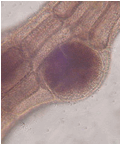
Close-up of branch tip and trichoblasts Close-up of tetraspore
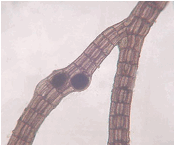

Branch and tetraspores Close-up showing numerous pericentral cells
Polysiphonia
subtilissima
Polysiphonia subtilissima is an alga with 4 pericentral cells. The plant is dark red to purple in color and may reach 15 cm in height. Branching is irregular, but often subdichotomous below and alternate above. Cells 1 to 8 diameters long. The cells at the apex of the branchlets are conspicuous. Main axes 60-80 microns in diameter; branches above 35-45 microns. Colorless filaments (i.e., trichoblasts) often forked. (See Dawes & Mathieson, p. 311; Littler & Littler, p. 234; Taylor, p. 575)

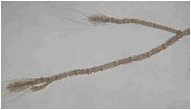
Polysiponia subtilissima habit Branching and branch tips
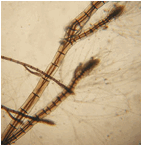

Neosiphonia ferulacea ( larger) Branching
and Polysiphonia subtilissima (smaller)


Pericentral cells Closeup of branch end of Polysiphonia subtilissima
Polysiphonia
havanensis
Polysiphonia havanensis is an alga of 4 pericentral cells. Plant may reach 9 cm tall and the main axes are 50 to 90 microns in diameter. Segments 1 to 3 diameters long. Branching is subdichotomous below and alternate above. The apices of the branches with numerous colorless filaments (i.e., trichoblasts). Branches arise at the base of the colorless filaments (i.e., in the axils of the trichoblasts). (See Dawes & Mathieson, p. 308; Littler & Littler, p. 228; Taylor, p. 577)


Plant habit of Polysiphonia havanensis Upper portion of plant
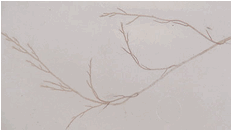

Branching pattern Apex of plant with trichoblasts


Close-up of apex Close-up of trichoblast
Polysiphonia
macrocarpa
Polysiphonia macrocarpa is a plant with 4 pericentral cells. Plant fairly small, to 2 cm tall. The main axes 100 to 150 microns in diameter. Branches do not arise at the base of the colorless filaments (i.e., in the axils of the trichoblasts). (See Dawes & Mathieson, p. 306; Littler & Littler, p. 224; Taylor, p. 572)
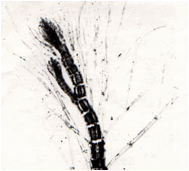
Close-up of apex of
branch of Polysiphonia macrocarpa
showing trichoblasts
Neosiphonia
ferulacea
Neosiphonia ferulacea is a plant with 4 pericentral cells. Plant may reach 15 cm in height. The main axes are 200 to 300 microns in diameter. Cells one diameter or less in length. Branches do not arise at the base of the colorless filaments (i.e., in the axils of the trichoblasts). (See Dawes & Mathieson, p. 298; Littler & Littler, p. 226 and Taylor, p. 578 (Polysiphonia ferulacea))



Part
of plant of Neosiphonia ferulacea
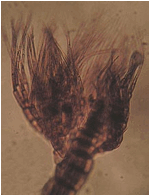
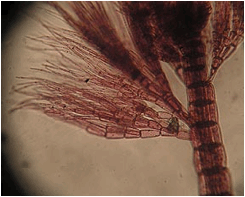
Branch apex Close-up of trichoblasts
Coelothrix
Coelothrix irregularis is a plant with a stiff, wiry texture. The filaments are rounded and may taper. In cross section, the larger branches have an outer wall of small cells, cells increasing in size toward the center. Plant may have a bluish color. (See Dawes & Mathieson, p. 370; Littler & Littler, p. 136; Taylor, p. 488)
Wurdemannia
Wurdemannia miniata is comprised of rounded and slender, but fairly stiff filaments. Diameter of branches 150 to 400 microns. Plant entangled below, less branched above. In cross-section, the interior is comprised of large, thin-walled cells, the cortex of a single row of cells which appear rectangular in outline. (See (See Dawes & Mathieson, p. 336; Littler & Littler, p. 100; Taylor, p. 361)
Please choose one of the following options.
150a. Plant coarse with stiff branches, branches with many short spine-like branchlets…………………………………………………….…….….…Acanthophora
150b. Plant with firm branches, branchlets short and "spindle" or "cigar" shaped, usually with noticeable constrictions at base…………………………………….……..Chondria
150c. Plant with firm branches, branchlets short and without noticeable constrictions at base………………………………………………………….……Laurencia/Palisada
Acanthophora
Acanthophora spicifera is an erect plant that occurs in clumps of moderate size. It is reddish-brown in color. It is distinguished by numerous spine-like branchlets which are found on the larger axes of the plant. The main branches are rounded. (See Dawes & Mathieson, p. 274; Littler & Littler, p. 192; Taylor, p. 619)

Acanthophora plant habit

Portion of plant showing
spine-like branchlets
Chondria
Chondria is a genus of considerable variation. The main branches of Chondria are rounded, the branchlets are spindle or "cigar" shaped. The branchlets are usually constricted at the base and often show a tuft of colorless hairs (i.e., trichoblasts) at the apex. The main branches of Chondria have 5 pericentral cells in cross-section. (See Dawes & Mathieson, p. 280; Littler & Littler, p 196; Taylor, 610)
160a. Plant with spindle shaped branchlets, the pointed tip usually bearing colorless filaments (i.e., "trichoblasts")……………………………......…….Chondria capillaris
160b. Plant branchlets with sunken apices, the apices with colorless filaments (i.e., "trichoblasts"), axes .5 to .75 mm in diameter………….….……Chondria collinsiana
160c. Plant branchlets with sunken apices, the axes .75 to 1.25 mm in diameter. Plant dark purple in color…………………………….……….………Chondria cnicophylla
160d. Plant very large, axes to 2 mm, branchlets only in upper portion of plant, usually straw-yellow in color………………………………………..……....Chondria littoralis
Chondria
capillaris
Chondria capillarus is a plant with spindle-shaped branchlets that have pointed apices bearing colorless filaments (i.e., "trichoblasts"). The branchlets are 4 to 8 mm long and .25 to .5 mm in diameter. The plant may be as much as 20 cm tall and quite "bushy." (See Dawes & Mathieson, p. 282; Littler & Littler, p 198; Taylor, p. 613 (C. tenuissima))
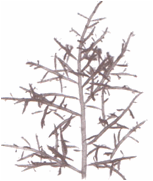
Main axis, branches, and branchlets
of Chondria capillaris
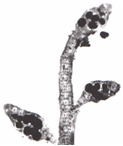
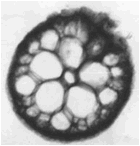
Close-up of branch tip Cross-section
and reproductive cells
Chondria
collinsiana
Chondria collinsiana is a plant whose branchlets have sunken apices; the apices bearing colorless filaments (i.e., "trichoblasts"). The branchlets are 2 to 5 diameters long. The main axes are .5 to .75 mm in diameter. Plant is yellowish to pinkish and soft in texture, usually growing on other algae or on sea grasses. (See Dawes & Mathieson, p. 283; Littler & Littler, p 200; Taylor, p. 617)
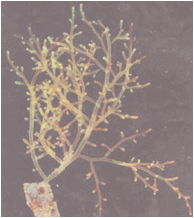

Photograph of Chondria collinsiana Closeup of branchlets (also note
attached to blade of Thalassia filament tufts at apex of branchlets)
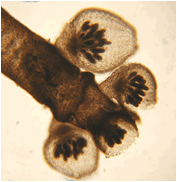
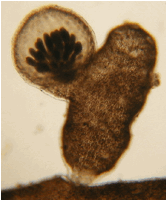
Cystocarps on branch Closeup of cystocarp
(SEE NEXT
PAGE)
Page 163A
Chondria
collinsiana
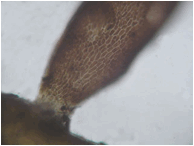
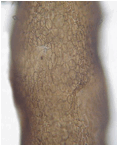
Branch showing constricted base Cell pattern
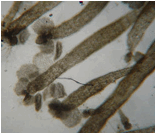

Branches with spermatangial sori Close-up of sorus
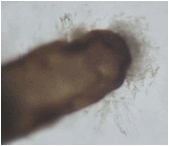
Apex of branch with fine filaments
Chondria
cnicophylla
Chondria cnicophylla is an alga whose branchlets have sunken apices. The branchlets less than 4 mm in length. The main axes .75 to 1.25 mm in diameter. Plant dark purple in color and up to 2 dm in height. (See Dawes & Mathieson, p. 282; Littler & Littler, p 200; Taylor, p. 614)
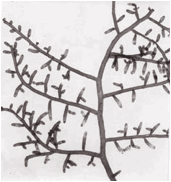
Portion of plan showing habit
and nature of branchlets
Page 166
Chondria
littoralis
Chondria littoralis is a large plant (to 35 cm in height) and usually straw yellow (though sometimes more reddish or brownish). Branching irregular. Branches to 2 mm diameter and with few or no branchlets below. Mature surface cells 1 to 4 diameters long, diameters to 19 microns. Branchlets are considerably smaller than branch, tapered at both ends, up to .5 mm in diameter, and with a pointed apex that shows fine filaments. (See Dawes & Mathieson, p. 285; Littler & Littler, p. 204; Taylor, p. 612)


Habit of Chondria littoralis Branches and branching pattern
Laurencia
and Palisada
Laurencia
and Palisada are genera that show
considerable variation in both size and color. All species are characterized by rounded main branches and
short, often stubby, branchlets which are not noticeably constricted at their
bases. (See Dawes
& Mathieson, p. 291/302; Littler & Littler, p. 210; Taylor, 621)
170a. Plant yellow to green to greenish purple in color with many close-set, short branchlets, no surface projections……....…………………….…….Palisada papillosa
170b. Plant yellow to green to greenish purple in color with many close-set, short branchlets, microscopic surface projections present…….………..Palisada gemmifera
170c. Plant with straw-colored to greenish axes and pinkish to rose-colored branchlets. Little branching in lower portion of plant………………....……..….Laurencia obtusa
170d. Plant straw-colored with pinkish to rose-colored branchlets. Branchlets usually down-curved...............................................……………….…...….Laurencia intricata
170d. Plant straw-colored to light pink with pinkish to rose-colored branchlets. Branchlets usually up-curved. Branchlets club or peg shaped and 1-4 mm long.............................................................……….…...…….Laurencia chondrioides
170f. Plant tan to pink, branchlets not crowded on upper parts……..Palisada poiteaui
Palisada
papillosa
Palisada papillosa is characterized by numerous very short branchlets which cover the main axes. The plant is yellow to greenish to greenish purple. It is often short and stubby when growing in shallow water. (See Dawes & Mathieson, p. 303; Littler & Littler, p. 218; and Taylor, p. 623 (Laurencia papillosa))
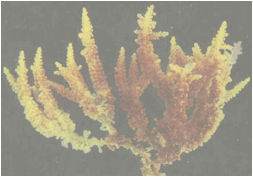
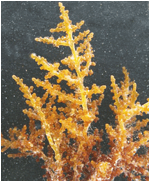
Plant habit of Palisada papillosa Branching
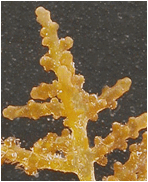

Close-up of very short branchlets Cross-section
Laurencia
obtusa
Laurencia obtusa is characterized by rose colored branchlets. Lower portions of the plant are sparingly branched in an alternate manner. Upper portions of the plant with many short branchlets in a variety of patterns. Branchlets .5 to .75 mm in diameter. (As seen in the photographs below, this species can take on a large number of habit and color patterns.) (See Dawes & Mathieson, p. 295; Littler & Littler, p. 216; Taylor, p. 626)
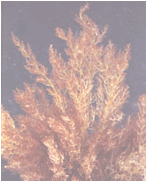
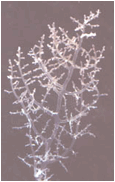
A fairly typical lush A sparsely branched
plant of Laurencia obtusa form of Laurencia obtusa
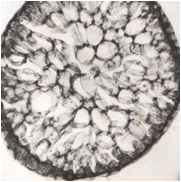
Cross-section
Palisada
poiteaui
Palisada
poiteaui is tan to buff to pinkish in color. Main axes stiff; branching is alternate. Ultimate branchlets not crowded and 1
to 1.5 mm in diameter. (See Dawes
& Mathieson, p. 304; Littler & Littler, p. 218 (Laurencia poiteaui); Taylor, p. 625 (Laurencia poitei)
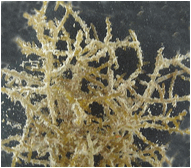
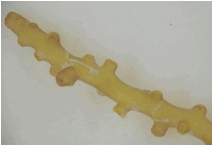
Habit of Palisada poiteaui Branch of Palisada poiteaui

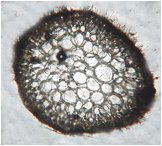
Tip of branch Cross-section
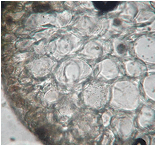
Close-up of cross-section
Palisada gemmifera
Palisada gemmifera is bushy and fairly stiff. Plant is yellow to green to greenish brown in color, sometimes with reddish tips. There are many close-set, short branchlets; microscopic surface projections present. Main branches 1 to 2 mm in diameter. Surface cells oval to angular, pigmented, and with pointed projections. (See Dawes & Mathieson, p. 302; Littler & Littler, p. 214; and Taylor, p. 624 (Laurencia gemmifera))
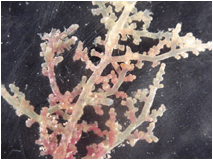
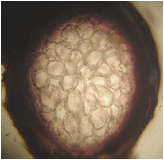
Branching of Palisada gemmifera Cross-section
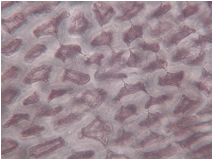

Surface cells with projections Edge-on close-up
of projections
Laurencia intricata
Laurencia intricata is yellow-brown in color, with rose colored branchlets. Branching sparse and irregular to alternate. Branchlets generally “down-curved.” Inconspicuous fine filaments emerge from apices. Surface cells 40 to 50+ microns in diameter. (See Dawes & Mathieson, p. 294; Littler & Littler, p. 214; Taylor, p. 626)
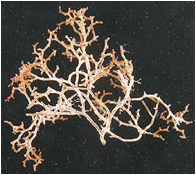
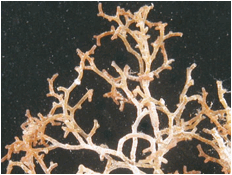
Habit of Laurencia intricata Branching showing down-curved branchlets
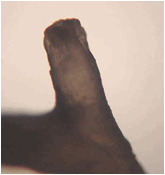
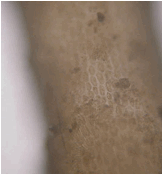
Close-up of club-shaped branchlet Cells on branch surface
Laurencia chondrioides
Laurencia chondrioides is straw-colored to light pink with pinkish to rose-colored branchlets. Branchlets usually up-curved. Branchlets club or peg shaped and 1-4 mm long. Mature surface cells 40 microns wide, 40 to 140 long. Apex sunken. (See Dawes & Mathieson, p. 294; Littler & Littler, p. 212; Taylor, p. 627)
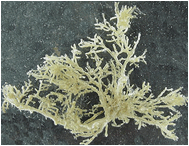
Habit of Laurencia chondrioides
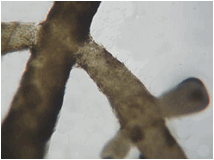
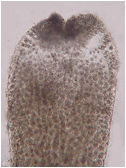
Peg-shaped branchlet Apex with sunken tip
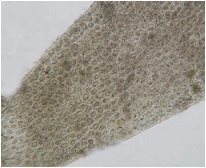
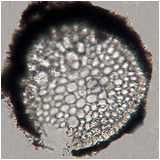
Cell pattern on
branchlet Cross-section of a medium
branch
Page 200
Please choose one of the following options.
200a. Plant purplish to black, main axis covered with numerous, stiff branchlets, giving the appearance of a bottle brush……………………………...………...………..Digenea

Digenea
simplex
200b. Plant purplish to black, alternate or pinnate (“feather-like) branching, tips of branchlets often "incurved"……………………………….…...………...……Bostrychia

Bostrychia
tenella
200c. Plant branches much entangled to turflike, red-brown, branchlets often occur at each joint, up-curved………………………………………………….….…..Murrayella

Murrayella
periclados
200d. Plant with prominent axes which are densely covered with fine, soft, reddish branchlets…………………………………………………………………………...Dasya

Dasya pedicillata
200e. Plant otherwise……………………………..…………………..….Go to page 201
Please choose one of the following options.
201a. Plant with prominent branches (.2 to .5 mm in diameter). Plant pinkish or white from a covering of lime. Plant usually slippery with mucous…………...…….Crouania

Crouania attenuata
201b. Plant with pinkish or reddish color, alternate branching, corticated by elongated cells, ultimate branchlets uniseriate, corticated at nodes, spine cell at the tip…...Spyridia

Spyridia filamentosa
201c. Plant pinkish to reddish, without surface cortication or corticated by filaments extending from the nodes, ultimate branchlets uniseriate and without cortication……………………………………………………………….….…Wrangelia

Wrangelia
penicillata
201d. Plant with main axis of numerous siphons, number of siphons decreases in succeeding branches. Ultimate branchlets monosiphonous………....…Heterosiphonia

Heterosiphonia
gibbesii
201e. Plant tall and tree-like, red to greenish-red or purplish in color.......Asparagopsis
![]()
Asparagopsis taxiformis
Digenea
Digenea simplex is recognized for its large main axis which is covered with many stiff branchlets, giving the appearance of a bottle brush. Branchlets are 3 to 7 mm long. Plant in cross section showing 6 to 8 pericentral cells. (See Dawes & Mathieson, p. 287; Littler & Littler, p. 204; Taylor, p. 588)
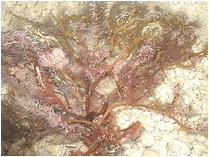
Habit of Digenea simplex
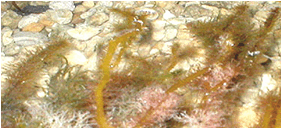
Top of plant
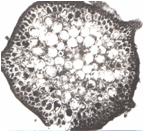
Cross-section of Digenea simplex
Bostrychia
Bostrychia is generally dark in color, ranging from dull purple to nearly black. Clumps of Bostrychia may get to 5 cm in height. Bostrychia is much branched in the upper parts, the branching of an alternate or pinnate (i.e., in the manner of a feather) nature giving the top of the plant the appearance of a Christmas tree. Branches are corticated and contain 6 to 8 pericentral cells. (See Dawes & Mathieson, p. 275; Littler & Littler, p. 192; Taylor, p. 594)
210a. Plant with little branching near base, the upper portions are densely and alternately branched……………………………….……………………...…..Bostrychia radicans
210b. Plant with little branching near base, the upper portions are densely and pinnately branched……………………………….……………………....…….Bostrychia tenella
210 c. Plant abundantly branched; branching alternate………..Bostrychia moritziana
Bostrychia radicans
Bostrychia radicans is a plant with 6 to 8 pericentral cells, but terminal branchlets monosiphonous. Little branching low on the plant, the upper portions are alternately branched. The terminal branchlets incurved. Bostrychia radicans is often found growing on rocks, pilings, or mangrove roots in the intertidal zone. (See Dawes & Mathieson, p. 277; Littler & Littler, p. 194; Taylor, p. 595)
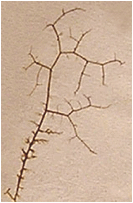

Branch of Bostrychia radicans Tip of branchlet
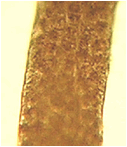
Cell pattern
Bostrychia tenella
Bostrychia tenella is a plant with 6 to 8 pericentral cells, but terminal branchlets monosiphonous. Little branching low on the plant, the upper portions are densely and pinnately branched. The terminal branchlets strongly incurved. Bostrychia tenella is often found growing on rocks, pilings, or mangrove roots in the intertidal zone. (See Dawes & Mathieson, p. 277; Littler & Littler, p. 196; Taylor, p. 599)
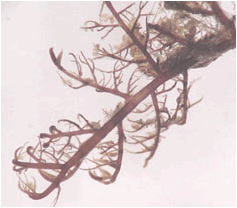
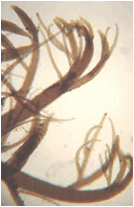
Portion of plant Ultimate branchlets
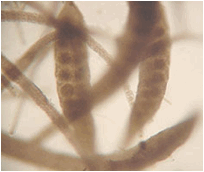
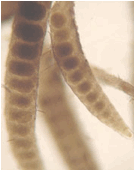
Branch tips and stichidia Tetraspores
Bostrychia moritziana
Bostrychia moritziana grows in brownish bushy clumps on mangrove roots. The plant has 7 or 8 pericentral cells; final branchlets monosiphonous. Branching is abundant and alternate. (Dawes & Mathieson, p. 276; Littler & Littler, p. 194, Taylor, p. 596)
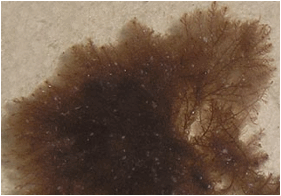
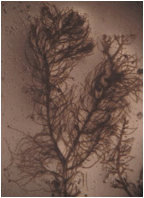
Habit of Bostrychia moritziana Portion of plant
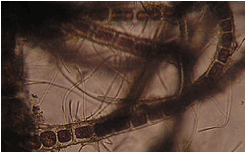
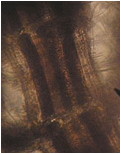
Close-up of cell pattern Close-up of pericentral cells
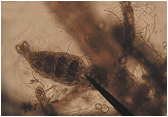
Tetrasporangia
Murrayella periclados
Murrayella periclados is much entangled to
turflike, red-brown, branchlets numerous, up-curved. Branching generally dichotomous in lower parts, alternate in upper
parts. Branches with four
pericentral cells. Branchlets
uniserate, cells 23 to 28 microns in diameter, 30 to 60 microns long. (See Dawes & Mathieson, p. 297; Littler & Littler,
p. 222; Taylor, p. 593)
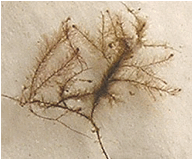
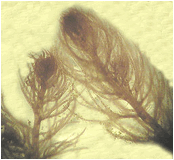
Habit of Murrayella periclados Top of plant
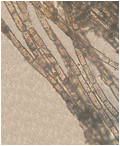
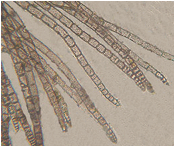

Cell pattern Cell pattern and tips of branchlets Reproductive cells
Dasya
Dasya baillouviana is a large plant with main branches to 3 or 4 mm in diameter. Dasya baillouviana is pink to red in color. Main branches often denuded below, but densely covered with fine soft filaments above. The main branches have 5 pericentral cells, ultimate branchlets monosiphonous. (See Dawes & Mathieson, p. 266; Littler & Littler, p. 170; Taylor (D. pedicillata))

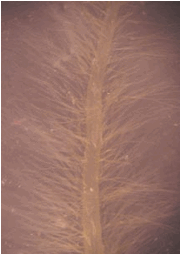
Habit of Dasya baillouviana Detail of branch
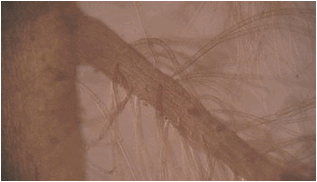
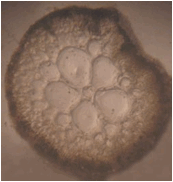
Close-up of branch and branchlets Cross-section
Crouania
Crouania attenuata is characterized by a mucousy feel and a deposit of lime. Main branches without surface cells. The branches have frequent bands of clustered whorls of small filaments (i.e, ramelli). The upper cells of these ramelli are 6 to 8 microns in diameter and 2 to 4 diameters long. (See Dawes & Mathieson, p. 236; Littler & Littler, p. 154; Taylor, p. 495)
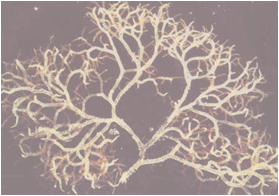
Photograph of Crouania attenuata showing habit and lime deposits on plant

Portion of plant showing whorls of ramelli
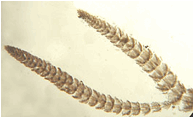
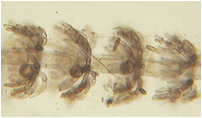
Branching and ramelli habit
Close-up of ramelli
Spyridia
Spyridia is a plant of pinkish or reddish (sometimes tan) color, alternate branching, and corticated by elongated cells. Ultimate branchlets a single row of cells, corticated at the nodes, with spine cell at the tip. (See Dawes & Mathieson, p. 246; Littler & Littler, p. 162; Taylor, p. 538)
225a. Branchlets with single terminal spine……………….……..…Spyridia filamentosa
225b. Branchlets with one terminal and one lateral spine cell……......Spyridia hypnoides
Spyridia
filamentosa
Spyridia
filamentosa is a plant of moderate size and generally straw-colored to
pinkish or rose. Main axes are
large (1 to 2 mm) and somewhat denuded below; in cross section showing an
interior of jelly-like material.
Alternate branching above with the ultimate branchlets a single row of
cells except for distinct bands of cortication at the nodes. Ultimate branchlets with a single
terminal spine. (See Dawes & Mathieson, p. 247; Littler & Littler, p.
164; Taylor, p. 539)
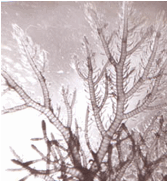
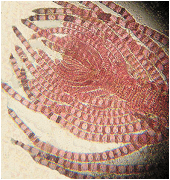
Portion of plant of Branchlets showing
Spyridia filamentosa cortication and spines
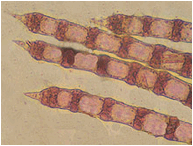

Branches showing cortication bands and spines at tip Cross section
Spyridia
hypnoides
Spyridia hypnoides is a plant of moderate size and generally straw-colored to pinkish or rose. Main axes in cross section showing an interior of jelly-like material. Alternate branching predominates throughout the plant. The ultimate branchlets are a single row of cells except for distinct bands of cortication at the nodes. Ultimate branchlets with a single terminal spine as well as a lateral spine. (See Dawes & Mathieson, p. 248; Littler & Littler, p. 164; Taylor, p. 541 (S. aculeata))
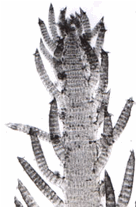
Portion of plant showing
terminal and lateral spines

Photograph of cross section
(jelly-like material in interior not visible)
Wrangelia
Wrangelia is pink or rose to reddish, without surface cortication or corticated by filaments extending from the nodes (sometimes giving the appearance of a tangled web of filaments associated with the node). Ultimate branchlets uniseriate and without cortication. In cross section, the older axes show scattered thin-walled cells. (See Dawes & Mathieson, p. 250; Littler & Littler, p. 166; Taylor, p. 502)
235a. Plant growing in mats 1 to 2 cm in height and dark pink to purplish red in color. Axes without cortical cells (or with a few filaments from the nodes serving as cortication)……………………………………………….………...….Wrangelia argus
235b. Plant of more than 5 cm (to as much as 20 cm) in
height. Axes corticated by the
downgrowth of filaments from the nodes…..……………….….Wrangelia penicillata
Wrangelia
argus
Wrangelia argus grows in mats 1 to 2 cm in height and dark pink to purplish red in color. Axes without cortical cells (or with a few filaments from the nodes serving as cortication). Ultimate branchlets uniseriate and without cortication. In cross section, the older axes show scattered thin-walled cells. (See Dawes & Mathieson, p. 250; Littler & Littler, p. 166; Taylor, p. 502)
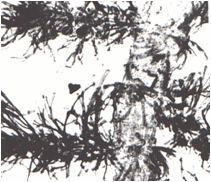
Small
portion of Wrangelia argus
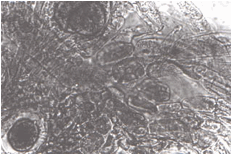
Close-up of branching
Wrangelia
penicillata
Wrangelia
penicillata is a plant of more than 5 cm (to as much as 20 cm) in
height. Alternate branching at
every node in upper portion of plant.
Axes corticated by the downgrowth of filaments from the nodes. Ultimate branchlets uniseriate
and without cortication. In cross
section, the older axes show scattered thin-walled cells. Branchlets generally tipped by a single
apical spine. Tips often rounded,
deciduous. (See Dawes
& Mathieson, p. 251; Littler & Littler, p. 168; Taylor, p. 503)
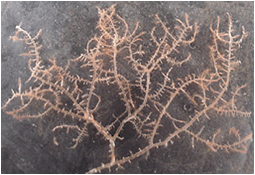
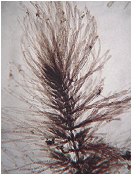
Habit of Wrangelia penicillata Apex
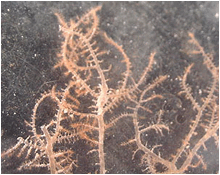
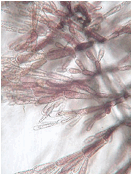
Portion of plant of Wrangelia penicillata Close-up of
ultimate branchlets
Heterosiphonia
Heterosiphonia species have a main axis of numerous siphons. The plants may have cortication below but are without cortication above. Heterosiphonia is generally light to dark pink to various shades of red. Smaller branches have reduced numbers of siphons in the upper parts of the plant. The ultimate branchlets are monosiphonous. (See Dawes & Mathieson, p. 270; Littler & Littler, p. 179; Taylor, p. 565)
245a. Plant large, sometimes reaching 20 to 25 cm in height. The lower part of the plant with a few branches and numerous siphons, the upper part of the plant with many fine filaments and monosiphonous………………...………….….Heterosiphonia gibbesii
245b. Plant small (up to 6 or 7 cm) and of a creeping or entangled habit. Mono-siphonous fine filaments are incurved and branched.……….Heterosiphonia crispella
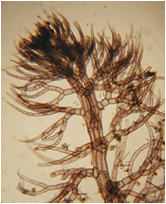
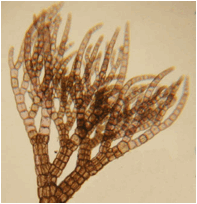
Apex of Heterosiphonia crispella Apex of Heterosiphonia gibbesii
Heterosiphonia
gibbesii
Heterosiphonia gibbesii is an erect plant of considerable size, sometimes reaching 20 to 25 cm in height. The lower part of the plant with a few branches and numerous siphons, the upper part of the plant with tufts of many fine monosiphonous filaments. The overall appearance is that of a whitish-pink to reddish tree. A key to identification is the gradual decrease in the number of siphons from the lower parts of the plant to the upper parts. (See Dawes & Mathieson, p. 271; Littler & Littler, p. 180; Taylor, p. 566)
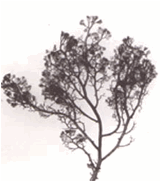
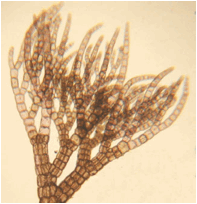
Portion of plant of Heterosiphonia gibbesii Close-up of siphon pattern

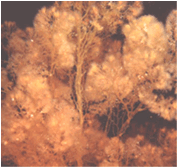
Tetraspores Color photograph of
Heterosiphonia
gibbesii
Heterosiphonia
crispella
Heterosiphonia crispella is a moderately small plant (to 6 or 7 cm) of a creeping or entangled habit. Monosiphonous fine filaments are attached to alternate segments and are incurved and branched. Main axis with 6 pericentral cells. (See Dawes & Mathieson, p. 271; Taylor, p. 565; Littler & Littler, p. 180; Taylor, p. 565 (H. wurdemannii))
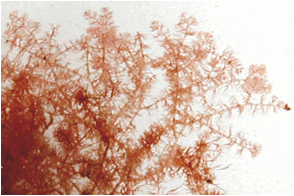
Habit of Heterosiphonia crispella
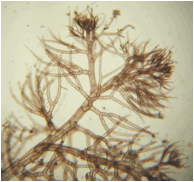
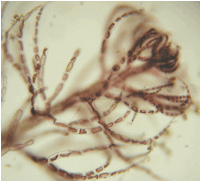
Close-up of upper portion of branch Close-up of apex
Asparagopsis
Asparagopsis taxiformis is a large plant with red and green colors. A large main axis, numerous branches of moderate size, and tufts of fine filaments make up the plant habit. These characteristics give Asparagopsis taxiformis a tree-like appearance. (See Dawes & Mathieson, p. 216; Littler & Littler, p. 68; Taylor, p. 348; Note: see also the page in this key for Falkenbergia hillebrandi, p. 90)
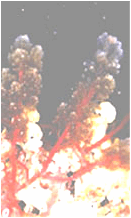
Habit of
Asparagopsis taxiformis
Page 270
Please choose one of the following options.
270a. Plant yellowish to tan to brown and with a generally "fleshy" character. Branches may decrease somewhat in diameter, but no very fine filaments present. Main axis in cross section with a central siphon and no pericentral cells………..…………….Hypnea

Hypnea
musciformis
270b. Plant pink to red and rubbery in character. Plants with no fine filaments. Axes in cross section show an inner structure of many small cells.....Eucheuma/Meristotheca

Meristotheca
gelidium
270c. Plant of bushy habit and fleshy character. Color may vary from brown to pink to red. Axes in cross section shows an inner structure of thin-walled cells……..Gracilaria

Gracilaria
tikvahiae
270d. Plant otherwise…………………………………………………...…Go to page 271
Please choose one of the following options.
271a. Plant stiff, wiry. Cross section shows an inner structure of thick-walled cells. Cells of outer cortex show pigmentation. Branchlets with single apical cell....Gelidiella

Gelidiella
acerosa
271b. Plant stiff, wiry. Filaments entangled, even mat-like. Apex of branchlets bluntly pointed, multicellular........................................................................................Gelidiopsis

Gelidiopsis
intricata
Hypnea
Hypnea
is a genus of fleshy red algae characterized by only modest variation in size
from main axes to ultimate branchlets.
Most species of Hypnea have a
brownish color and are moderate in size.
The plants may have some small branches, but no fine filaments. The main axes of Hypnea have a central siphon and no pericentral cells. However, it is not usual to select a
portion of a Hypnea plant and find 5
pericentral cells surrounding the central siphon. (See Dawes & Mathieson, p.
319; Littler & Littler, p. 76; Taylor, p. 465)
275a. Ends of branches somewhat flattened and shaped like a shepherd's crook……………………………………………………….…….Hypnea musciformis
275b. Ends of branches cervicorn (i.e., like a deer's antlers)……...….Hypnea spinella
Hypnea
musciformis
Hypnea
musciformis is brownish to purplish-red. The plant is moderate in size, sometimes reaching a height
of 20 cm. The plant is fleshy in
character and is distinguished by the shepherd's crook (or “crozier-like”)
branch tips. There are many short
branchlets throughout the plant. (See Dawes & Mathieson, p. 319; Littler &
Littler, p. 76; Taylor, p. 467)
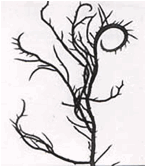
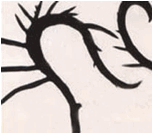
Portion of a branch Branch end showing
of Hypnea musciformis crozier-like shape
Hypnea
spinella
Hypnea
spinella is brownish to purplish-red.
The plant is moderate in size, sometimes reaching a height of 15
cm. The plant is fleshy in character
and is distinguished by the cervicorn (i.e., deer antler-like) branch
tips. There are many short
branchlets, some spur-like, throughout the plant. (See Dawes & Mathieson, p.
320; Littler & Littler, p. 78; Taylor, p. 466 (H. cervicornis))
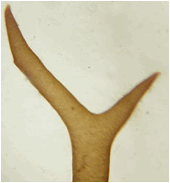
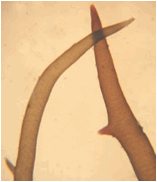
Cervicorn tip of Hypnea spinella Spur branchlets
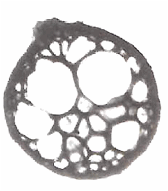
Cross-section to show central
siphon and irregular cells around it
Eucheuma/Meristotheca
Eucheuma
and Meristotheca are genera of
large plants with a fleshy character.
In cross section, the main branches show many thin-walled cells which
decrease in size toward the exterior.
Color is variable, but often brownish to various shades of reddish
purple. (See Dawes & Mathieson, p. 331/332; Littler & Littler, p. 94;
Taylor, p. 458)
290a. Plant with main axis and branches slightly flattened; oval to rounded in upper portions. Ultimate divisions may be cervicorn..........................Meristotheca gelidium
290b. Plant to 70 centimeters in height, pink to reddish in color, and rubbery in character. Plants with no fine filaments. Axis in cross section shows an inner structure of many thin-walled cells...............................................................................Eucheuma isiforme
Meristotheca gelidium
Meristotheca
gelidium is a large plant (to 30 centimeters or more) with main axis and
branches slightly flattened; branches oval to rounded in upper portions. Color is pale reddish to reddish-purple. Ultimate divisions may be cervicorn. (See Dawes & Mathieson, p. 333; Taylor, p. 458 (Eucheuma acanthodladum))
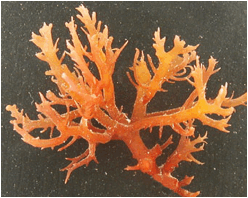
Habit of Meristotheca gelidium
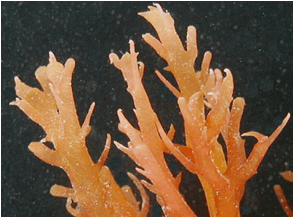
Upper branches and ultimate branchlets
Eucheuma
isiforme
Eucheuma
isiforme is a large plant; it grows to 70 centimeters in height. The plant is yellow to brown to pink to
reddish in color and rubbery in character. Plants have no fine filaments but show a habit of spine-like
branchlets with pointed apices.
Axes decrease little in size.
Axis in cross section shows an inner structure of many small cells. (See Dawes & Mathieson, p. 332; Littler &
Littler, p. 94; Taylor, p. 458)
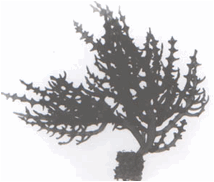
Habit of Eucheuma isiforme
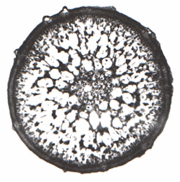
Cross section
Gracilaria
Gracilaria
is a large and varied genus. Most
of the species are bushy in habit and fleshy in character. Color may vary from brown to pink to
red. While many species have
rounded axes and branches, a few species are more flattened. Axis in cross section shows an inner
structure of thin-walled cells.
Unfortunately, reproductive structures are often necessary to complete
species identification. (See Dawes & Mathieson, p. 337; Littler & Littler,
p. 110; Taylor, p. 438)
300a. Plant large. Branching irregular, branches to 1 mm in diameter. Final branching dichotomous, apices pointed……………………………...……....Gracilaria tikvahiae
Gracilaria tikvahiae
Gracilaria tikvahiae is a large plant, to 30 cm in height. Branching irregular, branches to 1 mm in diameter, may be flattened somewhat below divisions. Final branching dichotomous, apices pointed. Interior cells of branches large and irregular, cortex 2 to 3 cells thick. (See Dawes & Mathieson, p. 346; Littler & Littler, p. 116: Taylor, p. 446 (G. foliifera))
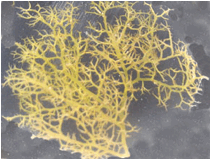
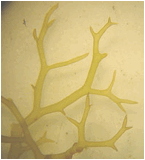
Habit of Gracilaria tikvahiae Ultimate branchlets

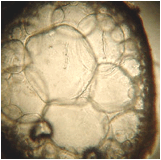
Cross section Close-up of large interior cells
Back
Gelidiella
Gelidiella acerosa is a stiff, wiry plant to 12 cm tall. Color may be dark red to reddish brown. Branches cylindrical (perhaps slightly flattened), ultimate branchlets 2 to 6 mm long. Small branchlets few below becoming numerous in the upper parts. Branchlets with single apical cell. Cross section shows an inner structure of thick-walled cells. Cells of outer cortex show pigmentation. (See Dawes & Mathieson, p. 317; Littler & Littler, p. 46; Taylor, p. 351)
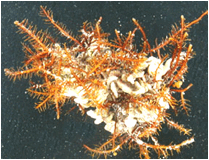
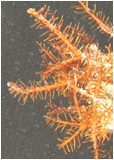
Habit of Gelidiella acerosa Portion of plant
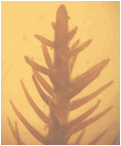
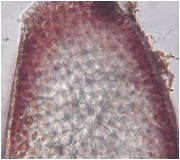
Upper portion of a branch Cells from longitudinal section
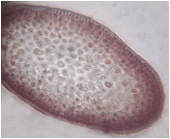
Cross section
Back
Gelidiopsis intricata
Gelidiopsis intricata is a wiry plant with stiff
branches. Filaments entangled
forming a mat. Branching
irregular. Apex of branchlets
bluntly rounded, multicellular.
In cross section, interior cells 20 to 30 microns in diameter, becoming
smaller toward the surface. Often
found on mangrove roots. (See
Dawes & Mathieson, p. 378; Littler & Littler, p. 124; Taylor, p. 353)

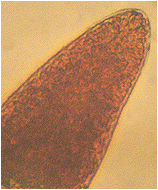
Habit of Gelidiopsis intricata Multicellular tip of branchlet
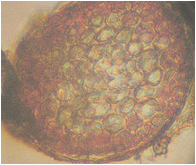
Cross-section